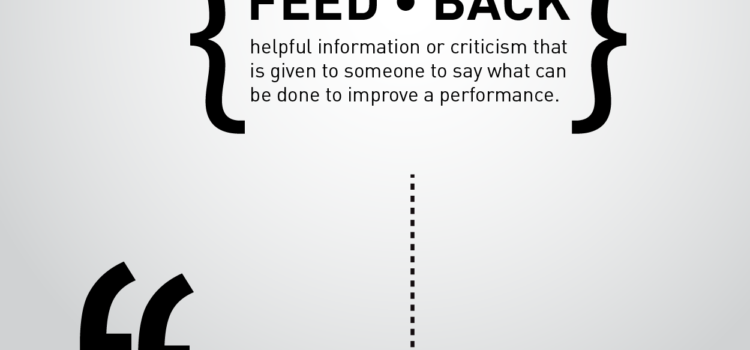“Employees want to be successful at work. It makes people feel good to perform well. But to perform well, employees need to understand what a job well done looks like.” – Madeline Homan Blanchard, executive leadership coach.
The above quote is from a great article I read this week in Talent Management magazine titled “Where Have All the Good Managers Gone?” This piece is jam-packed full of interesting commentary on effective employee and performance management, and the quote alone raises an interesting point.
How exactly do employees get a handle on what a ‘good job’ looks like? One way is through feedback, of course. But then what exactly constitutes good feedback? How can managers provide it? And are there certain rules or etiquette when it comes to delivering effective feedback?
No manager is perfect. And when it comes time to give good feedback to employees, there is always room for improvement. Here are a list of do’s and don’ts to keep in mind:
DO be sensitive. I think it’s safe to say that managers need to be diplomatic in their approach when it comes to providing feedback. Whether it’s during an annual review or spontaneously throughout the year, managers should be cautious in how they deliver criticism. Bullying or overloading an employee with negative feedback all at once is anything but useful, and could potentially do some serious damage to one’s ego.
DO provide constructive feedback on a regular basis. The ability to present good feedback goes hand-in-hand with truly knowing your employees and what they do day in and day out. This type of insight can be easily gained through regular conversations and weekly one-on-one meetings. A weekly meeting may seem like a lot, but it’s a necessary component of effective performance management. It not only helps you keep tabs on your employees and where they’re at, it in turn gives employees a better sense of what is expected of them making it easier for them to stay on top of their own performance.
DO give credit where credit is due. What might seem like a no brainer is often forgotten. Paying tribute to an employee when they’re on the right track is the simplest form of optimistic feedback. Sometimes a simple “great job” or “keep up the good work” goes a long way.
DO provide direction. In her article, Madeline Homan Blanchard brings forth the idea of “praise and re-direct.” Essentially, there are two types of feedback: positive and negative. With positive feedback should come praise, while with negative feedback should come re-direct. Meaning if a manager notices a struggling employee, they should not only provide input but a proper plan of action to help that employee grow and develop. Praise without direction or follow-up is like an empty promise; useless and meaningless.
DO automate: An automated talent management tool will give you everything you need to follow-up and re-direct. It allows you to document goals and development plans for your employees and then monitor results and progress, all from one central location.
DON’T limit feedback. Okay, so maybe I sound like a broken record when I say that performance management should be an ongoing process and not a once a year event but, it’s the truth. And seeing as how giving feedback fits comfortably under the performance and talent management umbrella, the same applies. Don’t wait until an annual review to provide feedback. You’ll only be setting yourself and your employees up for failure.
 One of your company managers is struggling with an under-performing worker, and so far, the manager has made all the right moves. The under-performance was addressed in the employee’s latest evaluation, coaching goals were set, and the manager has been following up on a regular basis. Every conversation has been documented, and HR has been kept in the loop at each step. But the manager’s efforts are not paying off. At this point, three warnings have been given, and it now looks like the employee will need to be dismissed.
One of your company managers is struggling with an under-performing worker, and so far, the manager has made all the right moves. The under-performance was addressed in the employee’s latest evaluation, coaching goals were set, and the manager has been following up on a regular basis. Every conversation has been documented, and HR has been kept in the loop at each step. But the manager’s efforts are not paying off. At this point, three warnings have been given, and it now looks like the employee will need to be dismissed.
 There is no doubt that leveraging timely, multi-faceted feedback can significantly bolster employee performance and development initiatives but can year-round feedback really replace the value of conducting annual reviews?
There is no doubt that leveraging timely, multi-faceted feedback can significantly bolster employee performance and development initiatives but can year-round feedback really replace the value of conducting annual reviews?

 FEEDBACK. It’s a tough one for HR, managers, and employees to deal with effectively and is often feared and avoided as if it were a bad word.
FEEDBACK. It’s a tough one for HR, managers, and employees to deal with effectively and is often feared and avoided as if it were a bad word.

 People are constantly getting and giving feedback in their daily lives – whether it is explicit through words or writing, or implicit through tone of voice or gestures. Feedback is an observation and evaluation of a particular action and can be highly effective for reinforcing or developing behavior, particularly when it comes to developing employee performance. The term feedback is defined as a ‘reaction’; however, we encourage organizations to think of employee feedback as carefully thought out mini-evaluations that take place continually – not just once a year.
People are constantly getting and giving feedback in their daily lives – whether it is explicit through words or writing, or implicit through tone of voice or gestures. Feedback is an observation and evaluation of a particular action and can be highly effective for reinforcing or developing behavior, particularly when it comes to developing employee performance. The term feedback is defined as a ‘reaction’; however, we encourage organizations to think of employee feedback as carefully thought out mini-evaluations that take place continually – not just once a year.